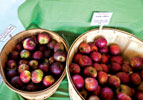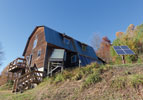For the Love of the Apples
 The apple tree was perhaps the last of its kind. Rooted in upstate New York, it produced an apple called the Bunker Hill. The fruit was orangey-red, streaked, spotted and speckled—and, according to apple literature, unseen for a century
The apple tree was perhaps the last of its kind. Rooted in upstate New York, it produced an apple called the Bunker Hill. The fruit was orangey-red, streaked, spotted and speckled—and, according to apple literature, unseen for a century
“I realized this was a very rare apple,” says Ron Joyner. “We had to get it.”
Joyner and his wife, Suzanne, own Big Horse Creek Farm, a small organic nursery, orchard and farm in the mountains of western North Carolina. A woman from New York had called because Big Horse Creek specializes in heritage apples, old strains with names like Limbertwig, which suburban sprawl and other pressures have nearly wiped out.

In the snowy winter of 1999, in Cortland, New York, the Joyners drove a Sno-Cat (a military-esque all-terrain vehicle) to the lone Bunker Hill tree, and snipped twigs for grafting. “It was like gold to me to have these [cuttings],” says Joyner, a bearded, soft-spoken former air-pollution re-searcher. “If this old tree had died before we found it, that variety would have been gone forever. And I just can’t abide with that.”The Joyners belong to a growing movement to preserve and enhance apple diversity—not just out of nostalgia, but to help determine how well, and maybe even how much, we’ll eat in decades to come. Their challenge: Notwithstanding your supermarket’s gleaming bounty of produce, in just one century America has lost most of its apples. In 1900, the U.S. had 20 million apple trees, according to nonprofit group Renewing America’s Food Traditions (RAFT). By 1950, it had just 5 million. Today (though official counts are unavailable) the number is “way down below that,” says RAFT founder Gary Nabhan.The decline is steeper in kinds of apples. According to one study, some 15,000 named varieties were once grown in North America. About 80% have vanished. Many faded because they were grown for traditional hard (i.e., alcoholic) cider, rather than fresh eating. Others vanished because grocery chains favor types that ship well, store well and radiate airbrushed perfection—your dozen most familiar varieties. Today, about 40% of all supermarket apples are just one type: the ubiquitous Red Delicious.
 The Joyners’ mission is manifest in the 375 varieties grown on their off-the-grid operation, from the Westfield Seek-No-Further to the regional favorite Virginia Beauty—apples pale yellow to purplish red, ridged or round, with broad spectrums of sweetness, tartness, spiciness and crispness.Appalachia nurtures apple traditions. The Joyners learned their trade from fellow North Carolinian Lee Calhoun, the godfather of modern apple conservation. Just two hours away lives Tom Brown, a retired Reynolds Tobacco re-searcher who drives back roads searching for old apple trees. He’s found more than 900 varieties. “They’re getting gone fast and the people who know the trees are getting gone,” says Brown, 69. “The time is running out to find them.”
The Joyners’ mission is manifest in the 375 varieties grown on their off-the-grid operation, from the Westfield Seek-No-Further to the regional favorite Virginia Beauty—apples pale yellow to purplish red, ridged or round, with broad spectrums of sweetness, tartness, spiciness and crispness.Appalachia nurtures apple traditions. The Joyners learned their trade from fellow North Carolinian Lee Calhoun, the godfather of modern apple conservation. Just two hours away lives Tom Brown, a retired Reynolds Tobacco re-searcher who drives back roads searching for old apple trees. He’s found more than 900 varieties. “They’re getting gone fast and the people who know the trees are getting gone,” says Brown, 69. “The time is running out to find them.”
In all, about 3,000 varieties are grown somewhere in the U.S. Most are produced in small quantities and sold at farmer’s markets and roadside stands. RAFT estimates that 80% survive in three or fewer orchards.
But the Joyners don’t live off sales of rarities like Hubbardston’s Nonesuch. Most of their trade is in “whips”—immature but ready-to-plant apple trees. The Joyners graft, grow and sell about 4,000 whips a year, shipping to orchards and hobbyists across the nation. “They’ll be growing out there somewhere,” says Joyner.

RAFT, an alliance of food, farming, conservation and culinary groups dedicated to at-risk foods, is part of the larger old-apple community. RAFT frequently teams with Slow Food USA, the 225-chapter advocate for the social, environmental and health benefits of eating locally and traditionally. In 2009, RAFT held the first-ever meeting of grassroots apple conservationists, in Madison, Wisconsin. And heirloom apples were the subject of Slow Food’s 2010 “forgotten fruit” summit in San Francisco.But it’s not all just apple tastings for foodies. Slow Food Russian River, for instance, is preserving the endangered Gravenstein, while Slow Food New York City is restoring the Newtown Pippin to the city where it originated in the early 18th century. Other signs of an apple resurgence include the renewed popularity of hard cider, which sells some 4 million cases a year in the U.S., up from about 120,000 cases in 1987.
Another issue is food security: Genetically diverse crops are more resistant to pests, blights and climate change. (The latter is already affecting operations at Big Horse Creek, where late-spring freezes and hot, dry summers decimated recent crops.) Moreover, the fruit in most processed-apple products Americans con-sume, including apple juice, is now grown overseas, primarily in China.
The apple ark is restocked one tree at a time. Take the Joyners’ Bunker Hill cuttings, which Ron Joyner has used to graft several new trees. “We brought this back from the edge of extinction,” he says. “It’s saved for posterity now.”
CONTACTS: Big Horse Creek Farm; Renewing America’s Food Traditions.

